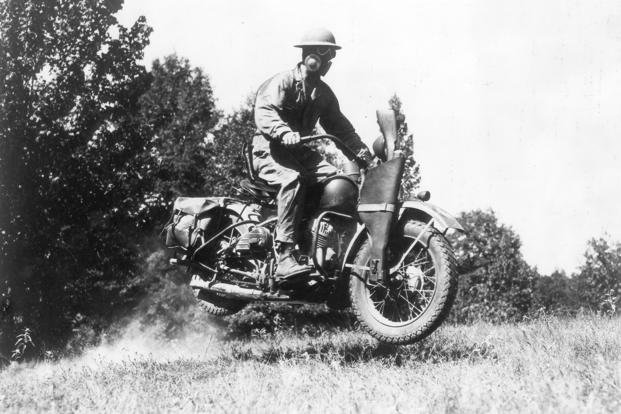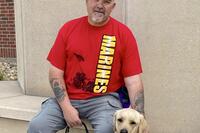How would you prefer to travel in a combat zone: trudging around on foot or ripping wheelies on a dirt bike with your M4 and night vision? It’s an obvious choice, and the U.S. military has employed motorcycles in combat many times throughout its history.
Military motorcycles have played a role in chasing Poncho Villa across northern Mexico, delivering messages throughout Europe in World War II and reconnoitering the Middle East in support of the Global War on Terror. The concept sounds like a slam dunk –- motorcycles make for speedy and nimble transports for scouts and couriers –- but for one reason or another, every U.S. military iteration has been surprisingly short-lived and limited in application.
Why does the military keep reviving the idea? Maybe Americans just have an innate love for motorcycles. Maybe the allure of riding solo across enemy territory like a cavalry scout in the Wild West is too strong for decision-makers at the Pentagon to resist. Whatever the reason, every generation of American warfighters seems to dust off the concept of military motorcycles and give it a try.
Iron Horses, Mexican Revolutionaries and the War to End All Wars
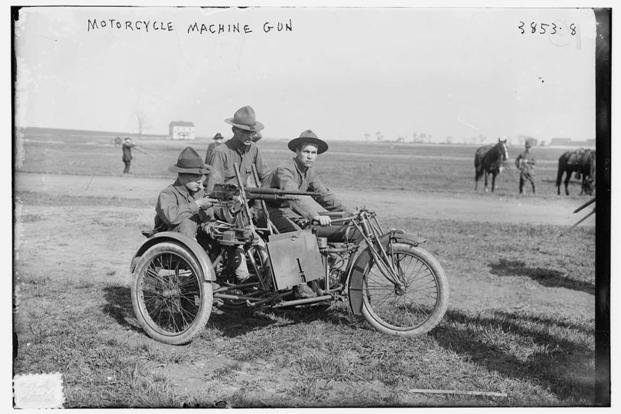
Horse-mounted cavalry was still considered viable military technology when World War I broke out. However, as Britain’s National Army Museum points out, the Great War quickly necessitated replacing hooves with tires. Immense artillery bombardments, poison gas attacks and machine guns made the battlefield comprehensively unsuitable for animals. Trucks replaced wagons, and motorcycles began to replace messenger horses.
America’s first militarized two-wheeler was Harley-Davidson’s J model. According to Harley-Davidson, The primitive motorcycle came with 15 horsepower, no front brake, no rear suspension and a gas lamp instead of an electric headlight. I suspect soldiers spent more time scraping mud off the chain than speeding across the bleak French landscape, but the J model didn’t go lame in the muddy fields, didn’t spook at the sound of explosions and didn’t need anything more than a tarp for a stable.
Still, the J model was a far cry from the dirt bikes of today. Its rough ride, low ground clearance and underpowered engine struggled everywhere but established roads –- and intact roadways could be hard to come by in a country that had endured years of artillery barrages.
If the trench warfare of World War I cast any doubt on the concept of military motorcycles, the Army’s scuffle with Poncho Villa along the U.S.-Mexico border showed its promise. Gen. John “Black Jack” Pershing used several Harley-Davidson J models to pursue Poncho Villa when the Mexican rebel managed to elude U.S. cavalry.
Pershing’s motorcycles were equipped with a sidecar and a machine gun. Rather than serving strictly as messengers, the two-man teams were well-equipped for maneuver warfare and could deliver far more firepower than a pair of cavalry scouts.
This was one of the first times motorcycles and airplanes were used in a coordinated military effort (and it may have been the first). It was a brilliant idea, and the biggest problem was finding soldiers who knew how to ride. So few motorcyclists existed in 1916 that Harley-Davidson had to step in and train soldiers how to use the J model.
Unlike the battlefields of France that were soggy, frozen or both, northern Mexico was a far better use case for combat motorcycles. Dry ground and clear skies created a perfect environment to showcase what a nimble and (relatively) fast vehicle could add to a commander’s arsenal.
A 1916 article in the Daily Capital Journal out of Salem, Oregon, reported that in 1,600 miles of testing, the J model could “travel over most any kind of ground at from 20 to 40 mph, get into action in 50 seconds and deliver 480 shots a minute.”
Harley-Davidson and Thompson: A Perfect Match
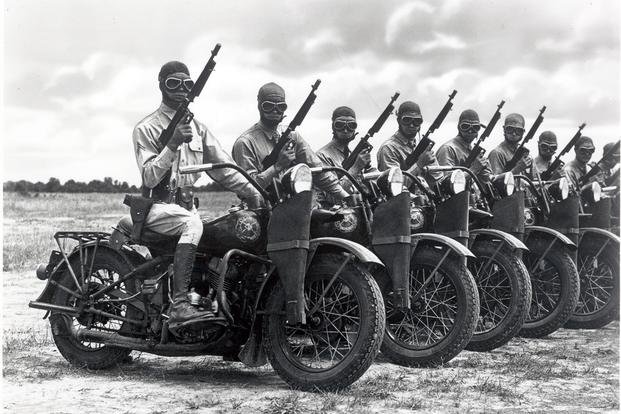
In the final years before the U.S. entered World War II, the Army sought to replace its J-model motorcycles with something more modern. According to the military history blog The Liberator, Harley-Davidson beat competition from Indian and Delco with the WLA to earn the Army’s business. The WLA went on to see use by military police, scouts and soldiers in armored units who needed fast, agile transportation.
Silodrome, an automotive and motorcycling blog, notes that Harley-Davidson reached back in the company catalog to source the engine for the WLA. Its flathead V-twin was famously strong, reliable, easy to maintain and tolerant of the poor-quality, 74-octane gasoline that was available on the front lines.
The 540-pound WLA was no doubt a handful off-road, but Harley-Davidson equipped military models with a skid plate, crash bars, more dirt-friendly fenders and an oil-bath air cleaner to improve off-road performance. The military’s motorcycles also got blackout lights, a luggage rack and (most importantly) a scabbard for small arms like the Thompson submachine gun. If there’s anything more American than riding around the battlefield on a Harley-Davidson with a Tommy gun, I can’t think of it.
With nearly 100,000 WLAs produced throughout World War II, it’s not uncommon to see one come up for sale. According to Classic.com, the average price of a WLA is currently around $30,000.
During World War II, Harley-Davidson briefly experimented with a boxer-engine, shaft-drive motorcycle called the XA. The XA, which was modeled after the German Army’s BMW motorcycles, was tougher and better suited to harsh terrain than the WLA, but it was nowhere near as popular. Ride Apart reports that fewer than 1,000 examples were built, and it is unlikely that any saw service overseas.
Dirt Bikes Tackle the Global War on Terror
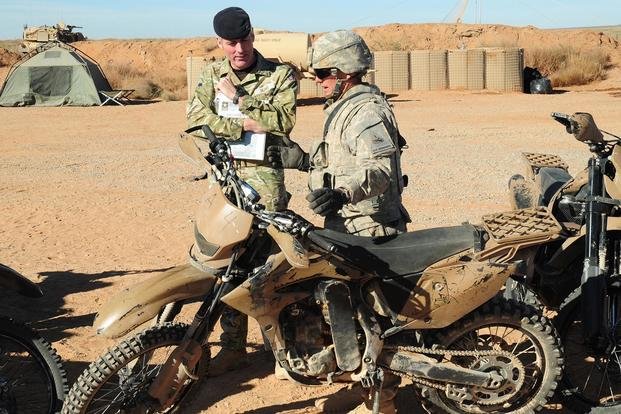
When Operation Enduring Freedom began in 2001, it didn’t take a military genius to survey the Afghan landscape and realize that oversized vehicles, such as the MTVR and HMMWV, wouldn’t be able to reach much of the battlespace, let alone in a hurry.
At the time, one of the hottest-selling, off-road motorcycles was the Kawasaki KLR 650. The civilian-market, dual-sport motorcycle was famous for being dependable and easy to ride. Its biggest limitation, as far as the military was concerned, was that its fuel-forward units simply didn’t run on gasoline. Fortunately, as The New York Times reported in 2008, a U.S. company named Hayes Diversified Technologies (HDT) had the solution: a new diesel engine for the KLR.
The Marine Corps jumped at the chance to conduct reconnaissance missions with the rugged new concept vehicle and adopted it as the M1030M1. Technically, the M1030M1’s engine ran on JP-8, a type of jet fuel similar to kerosene and diesel that’s become the military’s fuel of choice. “Diesel dirt bikes” has a nice ring to it, though, and that’s how many people remember the M1030M1.
The HDT engine was wildly efficient. According to the National Motorcycle Museum, one of the Marine Corps’ motorcycles achieved a top speed of 121 mph at the Bonneville salt flats, and covering more than 400 miles on a tank of fuel was commonplace.
Since the KLR and diesel engines are two of the most reliable creations in human history, it stood to reason that the M1030M1 would be virtually indestructible. Unfortunately for Marines in search of earning their combat wheelie badge, that wasn’t the case. As a YouTube video from The Bearded Mechanic explained, there are several ways to accidentally render the motorcycle inoperable in a hurry if you’re not careful.
Every so often, members of the public have a chance to buy an M1030M1. Owning a piece of history is always cool, but a quick visit to the Steel Soldiers military surplus vehicle forums reveals that these alternative-fuel bikes are notoriously unforgiving to work on, and sourcing parts for such a unique motorcycle is a serious problem.
The U.S. military wasn’t ready to quit on the idea of a combat dirt bike just yet, though, and there are photos of soldiers showing Italian-made Christini dirt bikes to international VIPs at Dona Ana, New Mexico, in 2012. The Christini AWD 450 had a modern motocross engine and a clever drivetrain that delivered power to both wheels. It wasn’t as good at packing gear as the M1030M1, but it was worlds better in speed and handling.
Silent But Deadly: The Future of Military Dirt Bikes
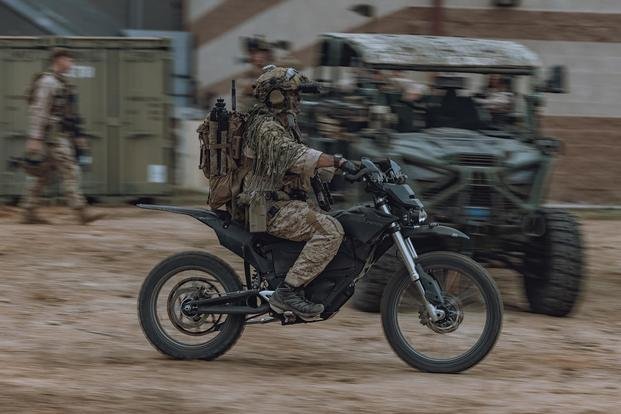
Modern attempts at militarizing motorcycles have had their challenges, but technology has added a new twist to the concept: electrification. Electric motorcycles have so much potential in the arena of maneuver warfare that the U.S. military can’t ignore them.
According to The Drive, Reconnaissance Marines have integrated the Zero MMX electric motorcycle into training leading up to deployment with the 15th Marine Expeditionary Unit (MEU).
The Zero MMX has several advantages compared to dirt bikes with internal combustion engines. Perhaps the biggest is noise; The electric motor’s quiet hum is far more stealthy than a thumping 450-cubic-centimeter, single-cylinder engine or shrieking two-stroke that leaves a cloud of blue smoke in its wake. It’s far less maintenance-intensive, too.
Electric motorcycles like the MMX are easier to ride because all the motor’s torque is available from a standstill and there’s no transmission or clutch to manage. Marines can charge the MMX like a normal EV or swap out depleted battery packs for fresh ones in seconds.
In addition to the inherent advantages of an EV, Zero offers options like passenger footpegs, tie-down points for cargo, and handguards for its military dirt bikes.
More than a century after the first motorcycles hit the battlefield, they remain too expensive and skill-dependent for widespread use in combat. The Zero MMX makes one thing clear, though: the value of combat motorcycles is alive and well. You just have to be part of an elite group to get your hands on one.
Want to Know More About the Military?
Be sure to get the latest news about the U.S. military, as well as critical info about how to join and all the benefits of service. Subscribe to Military.com and receive customized updates delivered straight to your inbox.
